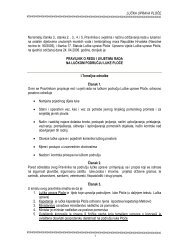HEADING PAGE - port of ploce authority * welcome
HEADING PAGE - port of ploce authority * welcome
HEADING PAGE - port of ploce authority * welcome
Create successful ePaper yourself
Turn your PDF publications into a flip-book with our unique Google optimized e-Paper software.
ENVIRONMENTAL IMPACT STUDY<br />
Rn: 03-033 CONTAINER TERMINAL PLOCE <strong>PAGE</strong>: 52<br />
A.3.5.2. THE SEA QUALITY<br />
A.3.5.2.1. DESCRIPTION OF THE LARGER AREA OF THE PROJECT<br />
Ploce is situated west from the Neretva estuary, where the Neretva flat delta<br />
touches the hilly karst areas. The <strong>port</strong>, as the principal economic branch has<br />
been developed at Ploce, situated at the beginning <strong>of</strong> the natural<br />
communication way along the Neretva valley. The nearest surroundings <strong>of</strong><br />
Ploce <strong>of</strong>fer great possibilities for development <strong>of</strong> tourist activities (the<br />
Bacinska lakes), and the Neretva estuary is very favourable for mariculture<br />
development. The Nature Park (ichtyological and ornithological reserve) is<br />
situated at the south-east side <strong>of</strong> the channel Vlaška–more.<br />
The town and the <strong>port</strong> Ploce occupy the east part <strong>of</strong> the Ploce bay. The<br />
densest urbanized part <strong>of</strong> the town and the <strong>port</strong> zone are situated between the<br />
Crna River and the channel Vlaška – more.<br />
Systematic researches <strong>of</strong> the coastal sea quality in the Neretvanski channel<br />
have been carried out for many years within the Project Vir – Konavle. The<br />
researches have been made by the Oceanography and Pisciculture Institute<br />
from Split for the requirements <strong>of</strong> the Hrvatske Vode («Croatian Waters») from<br />
Zagreb, Department for water and sea waters protection from pollution and<br />
contamination. The sea quality state is presented based on the results <strong>of</strong> the<br />
researches undertaken in the year 2002.<br />
The researches include the area from Gradac to the Malo More and the<br />
Prapratno cove. Figure 48. presents the sea research stations in the specified<br />
area. Station P1 is located in front <strong>of</strong> the Ploce town <strong>port</strong>. The investigation<br />
included climatological features <strong>of</strong> the area, physical and chemical properties<br />
<strong>of</strong> the sea water, biological properties and characteristic pollutants.<br />
The Neretva channel is characterized by variable hydrographic properties<br />
(temperature, salinity, density) conditioned by an interaction with the<br />
atmosphere, the influence <strong>of</strong> fresh waters, first <strong>of</strong> all those from the river<br />
Neretva, as well as by exchange <strong>of</strong> water with other parts <strong>of</strong> the Adriatic<br />
(Table 1). Influence <strong>of</strong> fresh water inflow is reflected in variations <strong>of</strong> the<br />
surface salinity, between 32.28 – 34.53 psu. The lowest salinities are<br />
registered in April, then in July, while in December minimum values were a bit<br />
higher. In warmer season a vertical temperature stratification is noticed, where<br />
thermo cline is pronounced, contrary to almost homogeneously mixed strata in<br />
colder part <strong>of</strong> the year (December - April).<br />
In the Neretvanski channel, influence <strong>of</strong> the gradient incoming stream <strong>of</strong><br />
north-west direction is registered. The sea streaming in front <strong>of</strong> Ploce is under<br />
considerable influence <strong>of</strong> the river Neretva flow, whose estuary is situated<br />
south from the town. The river Neretva flow accelerates the sea streaming<br />
along the shore in north-west direction, so we can suppose that this fact is<br />
favourable for taking <strong>of</strong>f the town and the <strong>port</strong> pollution from the Neretvanski<br />
channel. The same favourable effect is achieved by mixing <strong>of</strong> water with<br />
seawater <strong>of</strong> the Hvarski and Bracki Channel.<br />
The limpidity ranges between 7 and 25 m. The lowest and very uniform<br />
limpidity is registered at the station P1 that is under most expressed influence<br />
<strong>of</strong> sweet waters: 7 – 9 m. A higher limpidity and its larger ranges are recorded<br />
RIJEKAPROJEKT d.o.o.



